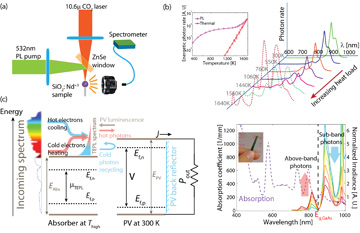 (a) Experimental setup of thermally enhanced photoluminescence (TEPL) experiment. (b) TEPL spectral evolution with increasing temperature. Inset: TEPL energetic photon rate at λ < 850 nm (purple) compared with thermal emission (red). (c) TEPL converter energy scheme. (d) Cr:Nd:Yb glass absorption spectrum (dotted purple line) and TEPL emission spectrum (colored lines).
(a) Experimental setup of thermally enhanced photoluminescence (TEPL) experiment. (b) TEPL spectral evolution with increasing temperature. Inset: TEPL energetic photon rate at λ < 850 nm (purple) compared with thermal emission (red). (c) TEPL converter energy scheme. (d) Cr:Nd:Yb glass absorption spectrum (dotted purple line) and TEPL emission spectrum (colored lines).
Optical cooling of solids exploits the ability to draw heat through photoluminescence (PL), with the laser source inducing blue-shifted PL.1 This efficient optical heat pump, however, has never been used to boost power conversion, as in solar energy systems.
We have recently shown that a similar thermal-up-conversion process takes place when a PL material (Silica:Nd3+ glass) is both photonically and thermally excited (panel a in figure).2 As heat is pumped to the system, the spectrum is blue-shifted (b in figure), while the total photon rate is conserved: the rate of low–energy photons (λ = ~900 nm) decreases, while the rate of higher-energy photons (λ < 850 nm) increases. This heat-pump effect continues until the onset of thermal emission (at 1500 K), at which point the spectrum sharply rises. The process results in high-energy photon emission at rates orders of magnitude above thermal emission.
Subsequently, we have demonstrated that a photovoltaic (PV) solar-energy converter based on this thermally enhanced PL (TEPL) effect can achieve efficiencies of 50 to 70 percent in moderate operating temperatures of 1000 K to 1500 K.3 The converter’s heart is a PL material with absorption cutoff energy EAbs (c in figure). The absorption of energetic solar photons excites PL, and the resulting electron thermalization raises the absorber’s temperature. This pushes emitted TEPL toward a PV of band gap energy Eg,PV > EAbs. Sub-band-gap photons are efficiently recycled to the absorber by the PV’s back reflector, as in state-of-the-art PVs; 4 thermal up-conversion generates energetic photons to be harvested by the high-band-gap PV. Combining a low-band-gap absorber and a high-band-gap PV is a key for achieving efficiencies above the Shockley-Queisser limit.
We have demonstrated this concept with a doped-glass broadband absorber (Cr3+:Nd3+:Yb3+) that has a continuous absorption (EAbs = 1.1 eV). The colored spectra in panel (d) of the accompanying figure shows the measured TEPL temperature evolution under white-light illumination (300 K to 1000 K), which simultaneously generates the PL and thermal excitations. The blue arrow shows the decrease in sub-band-gap photons; the red arrow, the increase of photons above the GaAs band gap. At 1000 K, about 30 percent of the PL photons are emitted in the desired high-energy interval.
Based on these results, we have simulated a practical TEPL device, in which the absorber is a doped glass cylinder surrounded by GaAs PVs. The simulations show, we believe, that power conversion efficiencies of up to 48 percent are within reach, at working temperatures lower than 1500 K.
Researchers
Assaf Manor, Nimrod Kruger, Tamilsaran Sabaphati and Carmel Rotschild, Technion–Israel Institute of Technology, Haifa, Israel
References
1. M. Sheik-Bahae and R.I. Epstein. Laser Photon. Rev. 3, 67 (2009).
2. A. Manor et al. Optica 2, 585 (2015).
3. A. Manor et al. Nat. Commun. 7, 13167 (2016).
4. T. Xiao et al., in Conference on Lasers and Electro-Optics, OSA Technical Digest, paper ATu1K.2 (2016).
